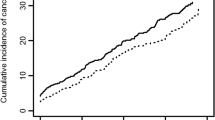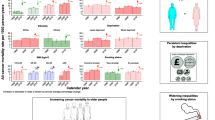Abstract
Background
The association between diabetes and cancer incidence has been well documented, but relatively little research has been undertaken on the potential influence of diabetes on cancer survival and the research that is available has produced inconsistent results. Because Indigenous Australians have a high prevalence of diabetes, we assessed survival, stratified by diabetes, among Indigenous Australian cancer patients. We also assessed survival, stratified by diabetes, amongst a cohort of non-Indigenous Australian cancer patients.
Methods
All-cause survival and cancer-specific survival in diabetic versus non-diabetic cancer patients were assessed in Indigenous and non-Indigenous cohorts separately, using proportional hazards models.
Findings
Indigenous cancer patients with diabetes (n = 140) had an overall survival disadvantage compared to Indigenous cancer patients without diabetes (n = 675) with all-cause Hazard Ratio (HR) = 1.4 (95% CI 1.1–1.8) adjusted for age, sex, and cancer site. After further adjustment to take into account the greater number of non-cancer deaths and co-morbidities in Indigenous cancer patients with diabetes, and their later stage at cancer diagnosis with less cancer treatment, there was no residual difference in cancer-specific survival compared to Indigenous cancer patients without diabetes (cancer-specific HR = 1.0, 95% CI 0.8, 1.3). Fewer non-Indigenous cancer patients had diabetes (n = 52) and they showed no differences in survival compared to their counterparts without diabetes.
Interpretation
The poorer survival of Indigenous Australian cancer patients with diabetes was due to more non-cancer deaths, later stage at cancer diagnosis, less cancer treatment, and more co-morbidities than Indigenous Australian cancer patients without diabetes. In contrast, diabetes did not appear to affect survival in non-Indigenous Australians with cancer, either because there were too few to detect a moderate deleterious effect or because there was no association. Understanding the relation between diabetes and cancer treatment and survival is important because both diabetes and cancer are relatively common diseases, increasingly likely to co-exist.
Similar content being viewed by others
References
Sperti C, Pasquali C, Piccoli A (1996) Survival after resection for ductal adenocarcinoma of the pancreas. Br J Surg 83:625–631. doi:10.1002/bjs.1800830512
Toyoda H, Kumada T, Nakano S (2001) Impact of diabetes mellitus on the prognosis of patients with hepatocellular carcinoma. Cancer 91:957–963. doi:10.1002/1097-0142(20010301)91:5<957::AID-CNCR1085>3.0.CO;2-J
Yanick R, Wesley M, Ries L (2001) Effect of age and comorbidity in postmenopausal breast cancer patients aged 55 years or older. JAMA 285:885–892. doi:10.1001/jama.285.7.885
Meyerhardt J, Catalano P, Haller D, Mayer R, MacDonald J, Benson A et al (2003) Impact of diabetes mellitus on outcomes in patients with colon cancer. J Clin Oncol 21:433–440. doi:10.1200/JCO.2003.07.125
Folsom A, Anderson K, Sweeney C, Jacobs D (2004) Diabetes as a risk factor for death following endometrial cancer. Gynecol Oncol 94:740–745. doi:10.1016/j.ygyno.2004.06.027
Chia V, Newcombe P, Trentham-Dietz A, Hampton J (2007) Obesity, diabetes, and other factors in relation to survival after endometrial cancer diagnosis. Int J Gynae Cancer 17(2):441–446. doi:10.1111/j.1525-1438.2007.00790.x
Little S, Jarnagin W, DeMatteo R, Blumgart L, Fong Y (2002) Diabetes is associated with increased perioperative mortality but equivalent long-term outcome after hepatic resection for colorectal cancer. J Gastrointest Surg 6:88–94. doi:10.1016/S1091-255X(01)00019-1
Satoh H, Ishikawa H, Kurishima K, Ohsuka M, Sekizawa K (2001) Diabetes is not associated with longer survival in patients with lung cancer. Arch Int Med 161:485. doi:10.1001/archinte.161.3.485
DeGiorgio R, Barbara G, Cecconi A, Corinaldesi R, Mancini A (2000) Diabetes is associated with longer survival rates in patients with malignant tumours. Arch Int Med 160:2217. doi:10.1001/archinte.160.14.2217
Australian Bureau of Statistics, Australian Institute of Health, Welfare (2005) The Health and Welfare of Australia’s Aboriginal and Torres Strait Islander Peoples. ABS, Canberra
Valery P, Coory M, Stirling J, Green A (2006) Cancer diagnosis, treatment, and survival in Indigenous and non-Indigenous Australians: a matched cohort study. Lancet 367(9525):1842–1848. doi:10.1016/S0140-6736(06)68806-5
Surveillance Epidemiology End Results (2001) Summary staging manual 2000: codes and coding instructions. National Cancer Institute, Bethesda
McKinnon P, Reichley R, Noirot L, Dunagan W, Bailey T.(2006) Prospective validation of an algorithm to identify hospitalized diabetic patients using administrative data. AMIA Annu Symp Proc 1029 (PMID 17238648)
Steiner E, Eicher O, Sagemuller J, Schmidt M, Pilch H, Tanner B (2003) Multivariate independent prognostic factors in endometrial carcinoma: a clinopathologic study in 1881 patients: 10 years experience at the Department of Obstetrics and Gynecology of the Mainz University. Int J Gynecol Cancer 13:197–203. doi:10.1046/j.1525-1438.2003.13021.x
Kaupplia A, Gronroos M, Nieminen U (1982) Clinical outcome in endometrial cancer. Obstet Gynecol 60:473–480
Weiser M et al (2004) Relation between the duration of remission and hyperglycemia during induction chemotherapy for acute lymphocytic leukemia with a hyperfractionated cyclophosphamide, vincristine, doxorubicin and dexamethasone/methotrexate-cytarabine regimen. Cancer 100:1179–1185. doi:10.1002/cncr.20071
Palanivel R, Maida A, Liu Y, Sweeny G (2006) Regulation of insulin signalling, glucose uptake and metabolism in rat skeletal muscle cells upon prolonged exposure to resistin. Diabetalogia 49(1):183–190. doi:10.1007/s00125-005-0060-z
Airley R, Loncaster J, Davidson S, Bromley M, Roberts S, Patterson A et al (2001) Glucose transporter Glut-1 expression correlates with tumor hypoxia and predicts metastasis-free survival in advanced carcinoma of the cervix. Clin Cancer Res 7:928–934
Author information
Authors and Affiliations
Corresponding author
Rights and permissions
About this article
Cite this article
Martin, J.H., Coory, M.D., Valery, P.C. et al. Association of diabetes with survival among cohorts of Indigenous and non-Indigenous Australians with cancer. Cancer Causes Control 20, 355–360 (2009). https://doi.org/10.1007/s10552-008-9249-z
Received:
Accepted:
Published:
Issue Date:
DOI: https://doi.org/10.1007/s10552-008-9249-z




